At Tesla, the customer experience falls far short of the car
I bought a Tesla. The experience of buying it was terrible. Analyzing the reasons for this is a great exercise in thinking through customer experience.
This is not my first electric car. I’m a believer. Six years ago, I bought a Nissan Leaf. My family has been very happy with it. The maintenance costs are minimal: no gas to fill, no oil changes, no muffler, and no exhaust. I can beat a Porsche off the line at a stoplight (for about two seconds, but still). I plug it into the charger at the end of my driveway every night and my kid drives it to college every weekday. We also have a hybrid SUV that we use for larger loads and longer drives.
But on my birthday this year, October 24, my wife and I appeared at the Tesla showroom in Boston for a test drive. I’d just read that a new version of the Tesla Model 3 was coming out with a price below $50,000. This more affordable version, the Mid Range Rear-Wheel Drive, has a range of 260 miles, which means that we’d only need to charge it once a week and could drive it just about anywhere, stopping at Tesla’s superchargers when necessary for longer drives.
I’d already checked in with a couple of friends who had Teslas and raved about them. “It’s beautiful tech, an iPhone on wheels,” said one. Another had been blogging about his experience. And my wife, who is not a fan of needless luxury or expense, voted hell yes. “This is a very nice car,” she said, and it is. From the huge center console screen to the display that shows all the cars around you by LIDAR, it’s awfully nice. So I put down a $2,500 deposit and ordered the car.
As you’ve no doubt read, Tesla has had production problems, making it a challenge to meet demand. Each car is built for the specific customer who orders it. In our case, the salesperson, Arnold, said the delivery time would be 6 to 10 weeks. (I’ve changed the names of all the Tesla employees in this story for reasons that will become clear.)
While I wasn’t in a rush to get the car, the timing was important. The reason: all electric cars in the U.S. come with a $7,500 tax break, which I needed to fit the car in my budget. That tax break ends when a manufacturer passes a sales milestone, and the Tesla break would end on December 31. So unless the car arrived by the end of the year, it would effectively cost $7,500 more.
That’s when the trouble began. Here’s a chronology of the comedy of errors that followed that initial order in late October:
- 24 Oct. Test drive, initial order placed, deposit for $2,500.
- 29 Oct. After some consideration, I decide to spring for one option that’s going to add a little extra cost: red paint instead of black. I go to my account on the Tesla site and follow the prompts to make the change. (Since the car won’t be manufactured for weeks, this change shouldn’t delay the delivery.) But while the site allows me to make the change, the change won’t stick; the car in my account stays stubbornly black. I email Arnold to request that he take care of this.
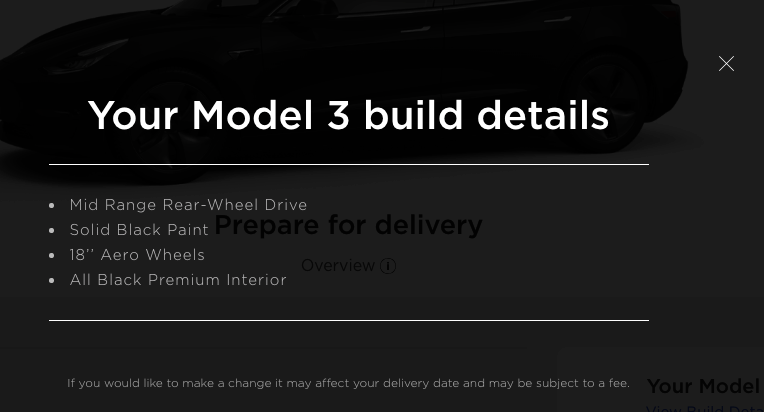
- 30 Oct. Arnold manages to fix the problem. The car in the Tesla account is now red, but it’s still the lower-cost Mid Range Rear-Wheel Drive model.
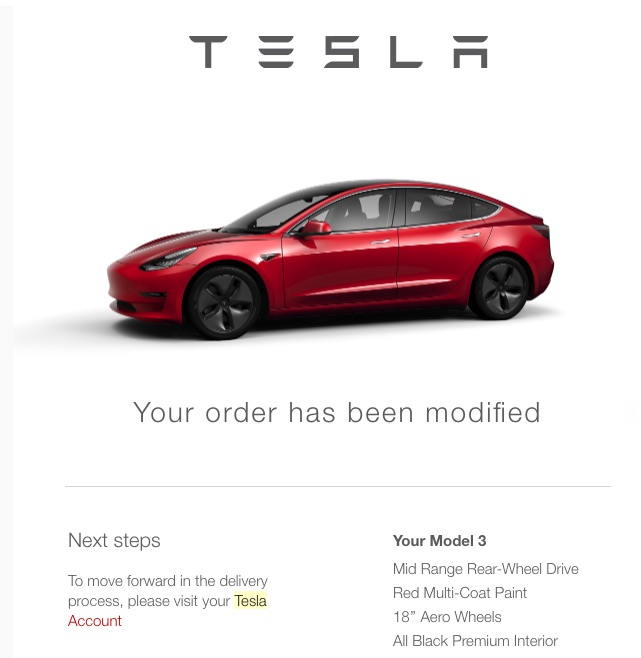
- 30 Oct. Arnold messages me asking for photos of the Nissan Leaf I intent to trade in.
- 31 Oct. I get an email indicating that my car’s features have been updated. It has the picture of the red Model 3 in it.
- 1 Nov. I hear from a new Tesla employee, Carl, in Las Vegas. His email indicates a delivery date of 3 December, weeks earlier than I’d hoped. Yay! He is confused about my name, he thinks I’m Thomas, but hey, nobody’s perfect. Carl asks for information regarding insurance and my trade-in. I ask him to coordinate with Arnold, who has been asking for the same things.
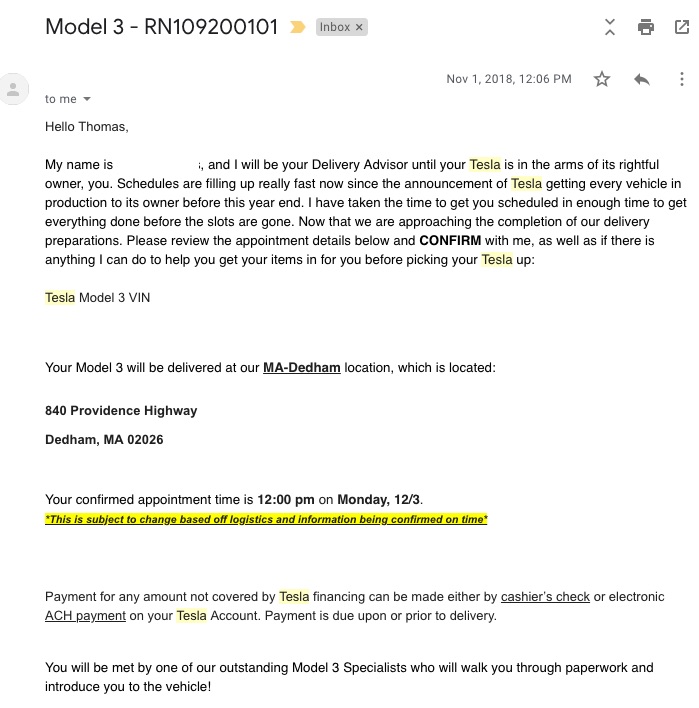
- 20 Nov. I get several text messages indicating that the Tesla is almost ready, and that it has been scheduled for delivery.
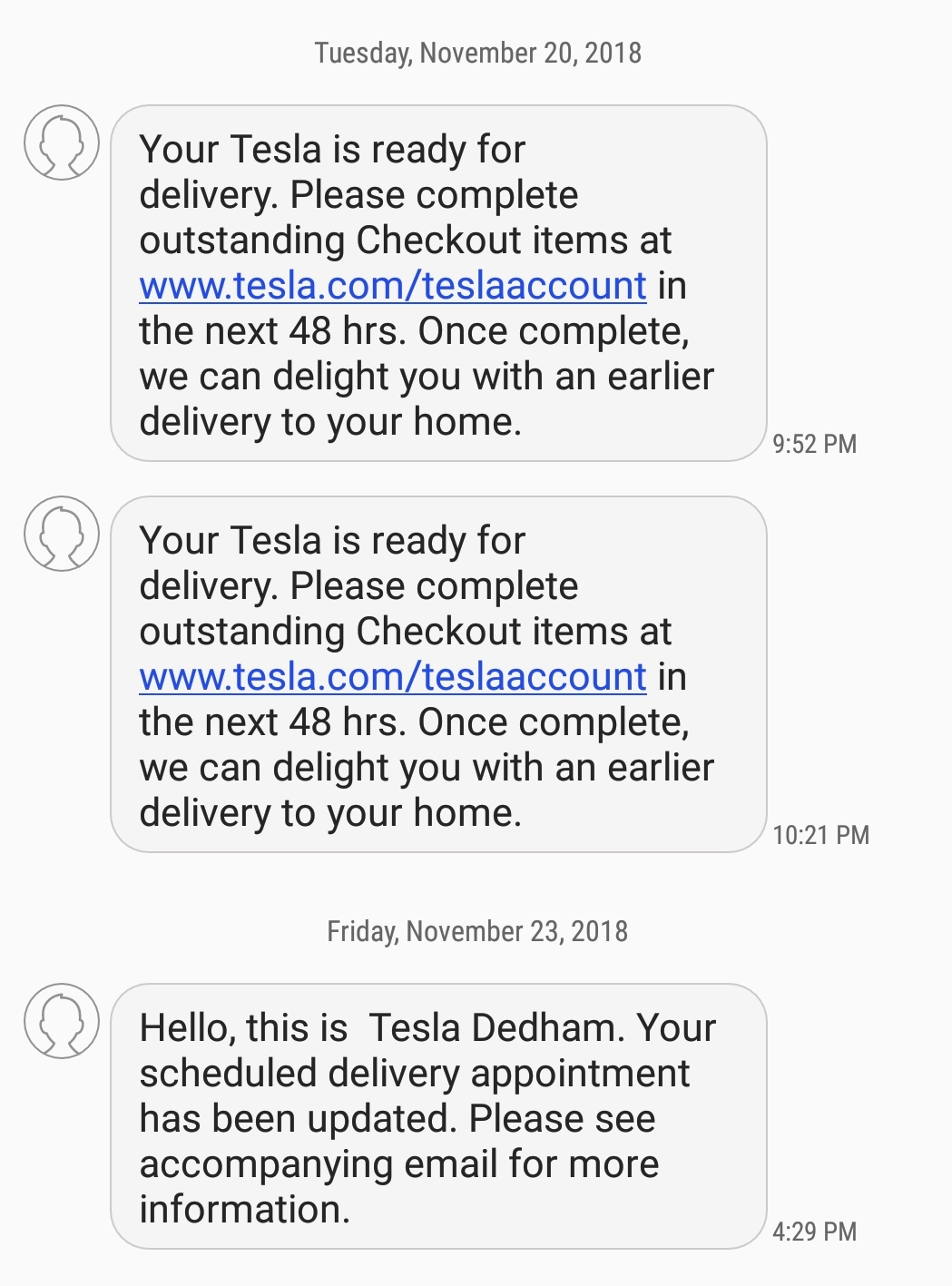
- 20 Nov. I suddenly realize there is a problem. The cost of the car has gone up by $8,000. I go back and investigate my order and find two things. First, the less expensive drive option has been swapped out for a more expensive Long Range 4-Wheel Drive option. (This sentence is in passive voice on purpose, for reasons you’ll soon see.) And second, my first name in the account is now Frederick. I call Carl in Las Vegas, but no one returns my call. Desperate, I call Arnold, the sales guy in Boston. When he gets back to me between test drives, he confirms that the account is changed and he will look into it. Within a few days, he tells me “No Tesla employee has made these changes.” This is astounding to me, because while it’s conceivable that I inadvertently changed the drive option in my futile attempts to change the color, it’s not possible that I changed my own name to Frederick. Who made these changes? Regardless of who’s responsible, Arnold says he will get this straightened out. He also says that as long as orders go in by November 30, Tesla is promising delivery by the end of the year (which I need to get the tax break).
- 23 Nov. Arnold says he will be able to make the changes after talking with some people at Tesla corporate.
- 23 Nov. I hear from a new person, Valerie, that my delivery date is now 7 December. I contact Arnold, who tells me to ignore this email from Valerie.
- 27 Nov. Carl in Vegas gets back to me with an offer for the trade in. It’s about $500 less than Arnold told me when we looked at it in the showroom. No further info about the unauthorized changes in the car’s configuration and cost.
- 28 Nov. After I’ve called and emailed Arnold every day or two, he says the problem is solved. It doesn’t look any different in my account, but he says to wait a few days.
- 29 Nov. The changes show up in my Tesla account and the price is back to what it is supposed to be. I’m hopeful that this means I’ll get delivery by year-end by given the mixups so far I’m concerned about that.
- 6 Dec. I decide not take trade in the Leaf. I search around for the place on the account page where I can delete my trade-in details and change that. I find it, but it’s under “modify your trade-in,” not at all intuitive.
- 7 Dec. Arnold estimates that the delivery date will now be around 15 Dec.
- 9 Dec. I get a text message that delivery will be scheduled for 5pm on Tuesday Dec 17. I arrange with my wife to drive down to Dedham that evening, a roundtrip which will take an hour and a half.
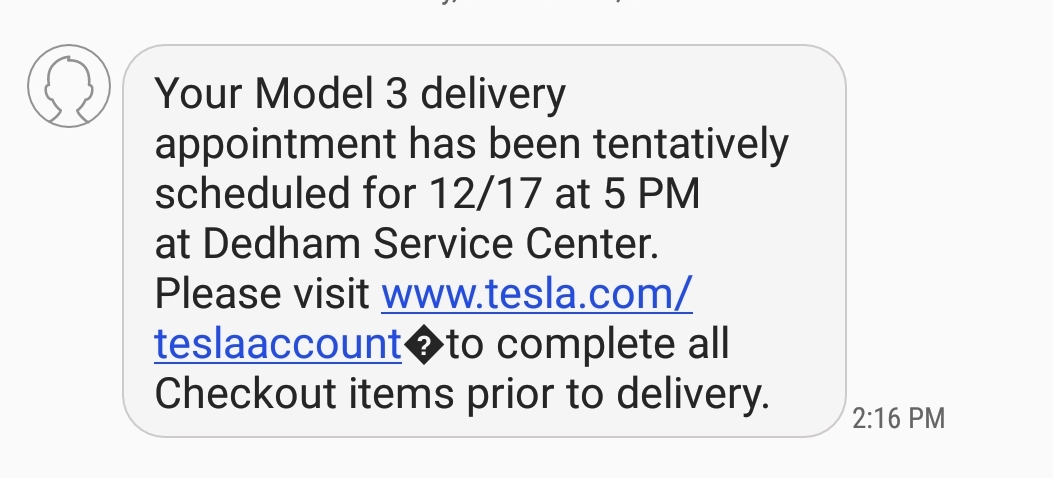
- 10 Dec. I get a phone call from Carl, whom I haven’t heard from in weeks. We discuss what it will take to get plates and insurance. Car is still scheduled for deliver one week later, 17 Dec.
- 15 Dec (Sunday). I receive an email that indicates that I’m ready to get delivery and need to take care of a few things, like payment. I enter my bank’s payment details and move money around to ensure there are enough funds to cover it. Since it is Sunday, I’m not sure the payment will go through by the following Tuesday, but I resolve to call and check on Monday.

- 16 Dec (Monday, day before scheduled delivery). I call the number in Dedham listed for delivery contacts. When I punch the voicemail option for delivery, it says that no one is answering and the mailbox is full. When I press 0, the only other delivery option I can get to on the voice mail says that this person is unavailable outside regular business hours (it’s 11am on a Monday). In desperation, I call Arnold again. He confirms that everything’s under control.
- 17 Dec (Tuesday, delivery day). I happen to log into my Tesla account and see that the delivery date has been shifted to Thursday, 20 Dec. I have received no email, voicemail, or text message about this. I call Arnold again. He tells me that they have had delivery delays, but that this new date is solid except for “acts of God,” like a snowstorm.
- 19 Dec. $50,000 disappears from my bank account.
- 19 Dec (evening). I get an email from Rohit in Dedham. He says that if I show up at 5pm the following day, the car may not be there. He has no idea of any of the other problems that have happened so far, and there has been no discernible act of God. He asks if I can pick it up on Friday instead. I say yes. He asks if I want to pick it up at 5pm. I say no. He says “Great, you’ll be there at 5pm.” I lose it. Then I calm down and make an appointment to pick the car up Friday midday. Rohit assures me that all the registration and insurance details are taken care of.
That’s the whole sordid saga so far. I will add a comment on here tomorrow about whether the car is ready as promised, and whether it lives up to my expectations.
Update: I picked the car up on Friday. The Tesla location in Dedham was a madhouse. Parking was virtually impossible. It took 90 minutes to get the car ready, even though they had told me it would take 15 minutes. There was some sort of problem with getting the keycards coded that took at least 40 minutes to solve. And I was frustrated by the representatives who me asked questions like “How will you be paying for the car” even though they had displays and pieces of paper right in front of them that indicated that it was already paid for.
It’s still a nice car. And the people scurrying around trying to help me were very hard-working and earnest. This is not a commitment problem. It is a systems issue.
The experience is more than the car
From everything I hear from owners, the Tesla design is extremely thoughtful and it is a model of what all cars should be — anticipating your needs and using technology to deliver on them.
Clearly, though, the design of the sales and delivery process isn’t quite there yet.
This is a great case study in how systems behind processes like auto sales can confound even the most committed employees attempting to give excellent service.
I have questions.
Why is Tesla using so many different channels — Web site, phone, email, text messages — in such an uncoordinated way?
Why are there so many different employees — Arnold, Carl, Vanessa, and Rohit — responsible for elements of my delivery, and why don’t they know what each other are doing?
Why is the sales guy the only guy who can get things done?
How can a company that builds such an amazing vehicle screw up with problems like full voicemail boxes and endless IVR loops?
As my college-age children have watched this saga unfold, it’s been interesting to see their reaction. My daughter, who is studying political economy and sociology this semester, asked me, “Is this a monopoly?” And it is. You can only buy a Tesla from the Tesla company, there is no competing set of dealers. And they know if you want the car, you’ll put up with the process. In my case, that meant a lot of fear, uncertainty, and doubt. I’m not happy with Tesla right now, even if though I hope to end up very happy with my Tesla Model 3.
Fixing this process will require just as much attention to detail and design thinking as it took to create the car. Tesla has apparently mastered its production problems. It should now turn its attention and intelligence to its delivery problem.
Josh, sorry to hear about your difficulties. I believe that most of your problems stem from Elon Musk’s decision to not have Tesla dealers. Having bought many cars, as you also have, the key was always the salesperson. You have only one person to deal with about everything and he or she has the incentive to make sure all goes well and that you will become a loyal customer. I hope that the rest of the process goes well and that you will enjoy your new Tesla for many years.
You should black out your home address in the screenshot you uploaded.
My home address is not secret, and this is not the only place it appears on this blog. But I hid it anyway, why not.
I placed two $1,000 deposits on Model 3’s the first day I could do so. I have since decided I don’t want a Model 3 and neither do either of my adult children (who would have paid for their own cars), so I’ve asked Tesla for a refund of my deposit. In principle Tesla will give me those refunds. In real life, I’ve been having a similar experience as Josh has had in actually buying a Tesla. Maybe I’ll get that refund some day, maybe I won’t. Frustrating.
But the Tesla is still a really nice car.
It’s Beginning to Look a Lot Like Christmas (EV Tax Credit Edition)
https://youtu.be/Oxm8WXe-Y-0
Update: I picked the car up on Friday. The Tesla location in Dedham was a madhouse. Parking was virtually impossible. It took 90 minutes to get the car ready, even though they had told me it would take 15 minutes. There was some sort of problem with getting the keycards coded that took at least 40 minutes to solve. And the representatives who me asked questions like “How will you be paying for the car” even though they had displays and pieces of paper right in front of them that indicated that it was already paid for.
It’s still a nice car. And the people scurrying around trying to help me were very hard-working and earnest. This is not a commitment problem. It is a systems issue.
Phew!
I have the same car, which I received earlier this year. Same experience: While the vehicle is amazing, the experience getting it was riddled with incompetence, contradictions, and broken promises. I doubt this is because Tesla is a so-called monopoly. Instead, I attribute the comedy of errors to massive growing pains and an erratic CEO. Also, Tesla is not a car company per se. A traditional car company focuses on things like customer service and haggling (of which, with Tesla, there is none). Tesla is a tech company that makes cars, so it’s focused more on things like robots, over-the-air updates, and the Supercharger network.
Interesting experience.
Last week my wife was doing some Christmas shopping at Stanford mall, and I dropped by the Tesla showroom there to see if there is anything new. In the past every time I visited every showroom car is swarmed with people and their kids so I have never actually had the opportunity to sit in one.
But this time I could and I played with the screen a little to see how it worked, and one of their sales critters approached me. I mentioned that I was interested by I would have to finance it and he worked through the possible deals on his phone for me.
Then I mentioned that I had gotten some e-mail that said November 30 was the last day you could order to get delivery this year, a requirement to get the full tax credit. (On Jan 1 it is still there but goes to half for the feds, but still full amount for California which is I think $2500.)
He replied “oh know if you want to buy today we can put you in a new one tomorrow.”
So I guess as the Internet is fond of repeating YMMV.
I live about 3 klicks from the Tesla plant and I drive by it every day, and on down Kato Road where my office is and Tesla has occupied a lot of properties. Along that road there are always dozens of car carrier trucks parked as overflow from Tesla’s main lot at the factory. They are constantly being loaded and staged. Also at one building with a largish parking lot that USED to be an R&D facility without a sign and now simply serves as a staging lot where consumers pick up their new vehicles. Always jammed full.
I think the experience in this blog post is simply a manifestation of growing pains that would occur in any startup that is experiencing hockey-stick growth. Combined with a culture that embraces, maybe too much, the adoption of new ideas rather than shunning everything new the way most corporate cultures do. If you just wanted the same old same old, go to the same old same old dealers that have been doing the same way for 50 years.
In other words, comes with the territory.
Your blog is centered on facts and the facts here are frustrating indeed! I can tell you were especially distressed because you started skipping words, and your blog is usually a typo-free space.
It may not be possible to edit the blog (or you may not want to) but if you go back, the ones I noticed were
I get (?) from Rohit
the representative who (?) me
Plenty of great stuff in this article. Many thanks!
Thanks. Updated to fix.